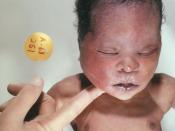Down Syndrome is a disorder caused by an extra chromosome on the chromosome 21 pair, giving the person a total of 47 chromosomes rather than the normal 46. This disorder results in mild to severe learning disabilities and physical symptoms including a small skull, extra folds of skin under the eyes, and a flattened nose bridge. The condition was formerly known as mongolism because the features of people with Down syndrome were thought to resemble those of Mongolian Asians but now this term is considered offensive and inappropriate so it's no longer used.
Down syndrome happens when a person inherits all or part of an extra copy of chromosome 21. This can occur in a variety of ways, but the causes of it are unknown. The most common abnormality is Trisomy 21, a defect in which an extra, third copy of chromosome 21 is present in every cell in the body.
The risk of Trisomy 21 is directly related to the age of the mother.
Two other chromosomal abnormalities cause Down syndrome and occur in about 2 to 3 percent of all cases:
Translocation, takes place when a child inherits a small extra piece of the 21st chromosome that is attached to another chromosome. If, in addition to the translocation, two normal 21st chromosomes are also present, the person will have some of the features of Down syndrome. If there is only one normal 21st chromosome, the person will not display symptoms but the children may inherit Down syndrome.
Mosaic Down syndrome results from a second type of chromosomal abnormality in which only some cells in the body have an extra chromosome.
There is no cure for Down syndrome. But there are tests before the baby is born that can identify if the baby will have Down syndrome. The American College of Obstetricians and Gynecologists recommends that the test called triple-screen blood test, to see if the baby has a Down syndrome, should be offered to all pregnant women. This test measures the levels of three chemicals in the blood of the pregnant woman to indicate the baby's risk of Down syndrome. If the risk is high, amniocentesis, a procedure for removing a sample of the amniotic fluid surrounding the fetus, is administered to confirm the findings from the blood tests. Fetal cells are present in the amniotic fluid and can be checked for the presence of the chromosomal disorder.
People with Down syndrome can have a variety of medical conditions. Heart abnormalities that sometimes surgery is needed, are present in about half of all Down syndrome cases. Thyroid problems affect 10% - 20% of people with Down syndrome, but these problems if they are treated can get better. The risk of acute leukemia is increased, although treatment is successful in most cases.
There have been dramatic increases in the survival rates of people with Down syndrome since the 1970s. As the risks of medical problems specific to Down syndrome have become known, doctors are now able to recognize those problems earlier, and develop more effective treatments. Today, 44% of people with Down syndrome survive to age 60, and this life expectancy is slowly approaching that of people without Down syndrome.
Although people with Down syndrome have a range of learning disabilities, physicians, educators, and parents now recognize that their achievements may be influenced by what is expected of them. This "environmental expectation" is perhaps the way to tell the educational and vocational potential of people with Down syndrome. On the other hand, intelligence-quotient test scores, once considered an authoritative indicator of educational potential, are now being questioned of their accuracy.
Educational and vocational opportunities have also advanced. In the recent past, children with Down syndrome were put to institutions, receiving minimal social interaction or educational opportunities. Today, children with Down syndrome usually remain with their families and are enrolled in public schools. Often they attend regular classes and learn skills such as reading and writing alongside children without Down syndrome. Adults with Down syndrome are employed in a range of fields. Some may live in supervised group homes, while others live independently.


